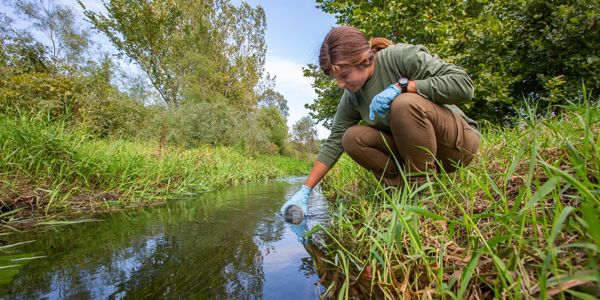
Finding Answers
Students in the College of Agriculture and Life Sciences are working with faculty to solve diverse, real-world problems. From assessing the effectiveness of stormwater buffers to testing grocery produce for harmful pathogens, young researchers are actively advancing research programs and receiving quality mentorship along the way.
Safety of the “10-second rule”
Every year, one in six Americans get sick from something they ate. Angela Shaw, a microbiologist, associate professor in food science and human nutrition and extension food safety specialist, works with students to reduce pathogens in our food supply.
In a recent research project, Shaw (’03 animal science, ’06 MS meat science) and graduate students she works with did some detective work to study implications of the “10-second drop rule” at the supermarket. Doctoral student Ana Monge-Brenes spent six months traveling around Iowa and the United States observing the way staff and customers behave in retail stores that sell food.
Despite rules to the contrary, the team saw produce being put back in display cases after spending seconds or even hours on the floor. Not a pleasant finding. But then, the question was, “How much difference does that make? How likely are people to get sick as a result?”
To find out, they tested leafy greens, apples, peaches and other produce in the retail display space lab in Iowa State’s Food Science building. The food was put in a variety of scenarios and exposed to harmful bacteria.
“What we learned was good news for consumers,” says Monge-Brenes. “The risk of produce picking up bad germs was very low. Even so, the project proves the wisdom of common advice, to wash your non-packaged produce when it comes home from the supermarket.”
In another recent project, Shaw and her students worked with Ajay Nair, associate professor of horticulture, to study the pathogen Listeria, linked to food-borne illnesses across the U.S. and a related recall of melons in 2012. Shaw’s team conducted field research analyzing the influence of past land use, different cropping practices and factors such as soil attributes, irrigation and use of cover crops.
In the field and in the lab, food science and horticulture undergraduate and graduate students took samples and looked at where bacteria showed up, how long pathogens were able to survive and under what conditions. One of the main risk factors they found was the history of the site, for example, if it had been previously used for waste disposal or livestock.
“The bad thing is that we discovered Listeria can survive for a long time in the soil, even through the temperature extremes of an Iowa winter,” says Shaw. “On the positive side, we found that increasing soil health could reduce the numbers of the harmful bacteria. Just improving the soil to increase good soil microbes was able to mitigate the likelihood of contamination.”
“Time and again, our research shows if you tweak little things, you can significantly decrease the chance that people will get sick and the likelihood of a recall,” says Shaw.
Capturing the rain
Are urban storm-water management practices adequate to protect life and property in the face of today’s weather? That timely question is a focus for Jan Thompson, Morrill Professor in the Department of Natural Resource Ecology and Management (’84 MS agronomy, ’91 PhD forestry), and her students.
Thompson is measuring the ability of urban conservation best management practices like riparian buffers, prairie plantings and rain gardens to capture and filter runoff to slow storm flows and improve water quality. Her team collects water, soil samples and other data at field sites along College Creek near campus and other locations in central Iowa they have tracked over time.
“A lot of urban stormwater management infrastructure is based on historical rainfall data,” says Thompson. “We’re finding that many practice design standards just can’t handle the type of extreme rainfall events that we know are becoming more common.”
The research documents the need to scale up the size of practices, like building rain gardens and other bioretention cells with larger surfaces to capture and infiltrate water and prevent much of it from flowing into storm sewers. Another recommendation from the research is to improve soil quality. This particularly applies to reconstructed prairie areas, which can be part of a number of urban storm-water practices.
Camille Karnatz (’17 MS environmental science) worked with Thompson on the project as a graduate student.
“We were surprised to find that reconstructed prairies, even after several years, often don’t infiltrate water as well as we expected they would,” says Karnatz, an environmental consultant in Minneapolis, Minnesota.
Thompson says prior land use in urban areas has generally degraded and compacted soils. Increases in porosity can take years to develop as the prairie matures. Improving soils during reconstruction, for example, with compost, can significantly increase infiltration to ensure practices start working sooner.
Two years ago, after one of Thompson’s classes was in the field looking at storm- water best management practices, Ames was hit with one of the season’s severe rain storms.
“We were out there in the downpour that night,” says Corey McKinney (’17 forestry) a natural resources specialist with the Iowa Soybean Association who was taking Thompson’s class at the time. “It was exciting to see how the installations we were studying performed, how they really drew the water in.”
Streets that had good storm-water management practices were clearly soaking up a lot of the rainfall. Others that didn’t were flowing like rivers, says Thompson.



